Fbxw7 haploinsufficiency loses its protection against DNA damage and accelerates MNU-induced gastric carcinogenesis
- PMID: 28422719
- PMCID: PMC5464881
- DOI: 10.18632/oncotarget.16800
Fbxw7 haploinsufficiency loses its protection against DNA damage and accelerates MNU-induced gastric carcinogenesis
Abstract
Fbxw7, a subunit of the SCF E3 ubiquitin ligase, recognizes oncoprotein substrates and leads to their proteasomal degradation. Fbxw7 acts as a tumor suppressor via inducing apoptosis and growth arrest in various kinds of tumors. To clarify the initiating role in gastric carcinogenesis as well as the histologic characterization of tumor in Fbxw7 allele haploinsufficient mice, we generated Fbxw7 heterozygous knockout mice (Fbxw7+/-) and treated them with chemical carcinogen N-methyl-N-nitrosourea (MNU) at 5-6 weeks of age. We also treated mouse embryo fibroblasts (MEFs) from Fbxw7+/- and Fbxw7+/+ mice with MNU and examined cell DNA damage via comet assay. The protein expression of Fbxw7 and its substrate c-Myc from mouse tumors, as well as human tumors sampled from six patients, were detected by Western blot. As results, the tumor incidence was obviously higher in Fbxw7+/- mice (13/20) than in Fbxw7+/+ mice (6/20) after 35-week observation. Intestinal metaplasia (P = 0.013) and dysplasia (P = 0.036) were more severe in Fbxw7+/- mice than in Fbxw7+/+ mice. The repair potential of DNA damage was suppressed in MEFs from Fbxw7+/- mice after MNU exposure. Increased c-Myc expression was accompanied by decreased Fbxw7 protein expression in tumor tissues from mouse and patients. In conclusion, Fbxw7 haploinsufficiency increased the risk of gastric carcinogenesis induced by MNU, which is associated with the accumulation of DNA damage as well as c-Myc oncoprotein.
Keywords: DNA damage; Fbxw7; N-Methyl-N-nitrosourea; gastric cancer; knockout mouse.
Conflict of interest statement
None.
Figures

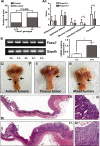
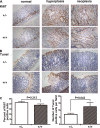
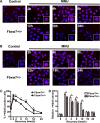
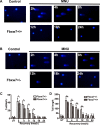

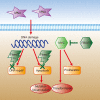
Similar articles
-
Loss of Fbxw7 triggers mammary tumorigenesis associated with E2F/c-Myc activation and Trp53 mutation.Neoplasia. 2020 Nov;22(11):644-658. doi: 10.1016/j.neo.2020.07.001. Neoplasia. 2020. PMID: 33070870 Free PMC article.
-
The FBXW7-NOTCH interactome: A ubiquitin proteasomal system-induced crosstalk modulating oncogenic transformation in human tissues.Cancer Rep (Hoboken). 2021 Aug;4(4):e1369. doi: 10.1002/cnr2.1369. Epub 2021 Apr 6. Cancer Rep (Hoboken). 2021. PMID: 33822486 Free PMC article. Review.
-
p53 knockout mice (-/-) are more susceptible than (+/-) or (+/+) mice to N-methyl-N-nitrosourea stomach carcinogenesis.Carcinogenesis. 2000 Oct;21(10):1891-7. doi: 10.1093/carcin/21.10.1891. Carcinogenesis. 2000. PMID: 11023548
-
Fbxw7 regulates tumor apoptosis, growth arrest and the epithelial-to-mesenchymal transition in part through the RhoA signaling pathway in gastric cancer.Cancer Lett. 2016 Jan 1;370(1):39-55. doi: 10.1016/j.canlet.2015.10.006. Epub 2015 Oct 13. Cancer Lett. 2016. PMID: 26458995
-
Recent insight into the role of FBXW7 as a tumor suppressor.Semin Cancer Biol. 2020 Dec;67(Pt 2):1-15. doi: 10.1016/j.semcancer.2020.02.017. Epub 2020 Feb 27. Semin Cancer Biol. 2020. PMID: 32113998 Review.
Cited by
-
Overexpression of F-box and WD repeat domain containing 7 prevents tumor growth of bladder cancer cells through regulating SREBP1a.Transl Androl Urol. 2022 Mar;11(3):367-376. doi: 10.21037/tau-22-146. Transl Androl Urol. 2022. PMID: 35402194 Free PMC article.
-
Transcriptomic and Genomic Testing to Guide Individualized Treatment in Chemoresistant Gastric Cancer Case.Biomedicines. 2020 Mar 23;8(3):67. doi: 10.3390/biomedicines8030067. Biomedicines. 2020. PMID: 32210001 Free PMC article.
-
FBXW7 in Cancer: What Has Been Unraveled Thus Far?Cancers (Basel). 2019 Feb 19;11(2):246. doi: 10.3390/cancers11020246. Cancers (Basel). 2019. PMID: 30791487 Free PMC article. Review.
-
Inhibition of Bcl6b promotes gastric cancer by amplifying inflammation in mice.Cell Commun Signal. 2019 Jul 9;17(1):72. doi: 10.1186/s12964-019-0387-6. Cell Commun Signal. 2019. PMID: 31288844 Free PMC article.
-
Molecular carcinogenesis of gastric cancer: Lauren classification, mucin phenotype expression, and cancer stem cells.Int J Clin Oncol. 2019 Jul;24(7):771-778. doi: 10.1007/s10147-019-01443-9. Epub 2019 Apr 12. Int J Clin Oncol. 2019. PMID: 30980196 Review.
References
-
- Ferlay J, Soerjomataram I, Dikshit R, Eser S, Mathers C, Rebelo M, Parkin DM, Forman D, Bray F. Cancer incidence and mortality worldwide: Sources, methods and major patterns in GLOBOCAN 2012. International journal of cancer Journal international du cancer. 2015;136:E359–386. - PubMed
-
- Tan Y, Sangfelt O, Spruck C. The Fbxw7/hCdc4 tumor suppressor in human cancer. Cancer letters. 2008;271:1–12. - PubMed
-
- Welcker M, Clurman BE. FBW7 ubiquitin ligase: a tumour suppressor at the crossroads of cell division, growth and differentiation. Nature reviews Cancer. 2008;8:83–93. - PubMed
-
- Cheng Y, Li G. Role of the ubiquitin ligase Fbw7 in cancer progression. Cancer metastasis reviews. 2012;31:75–87. - PubMed
MeSH terms
Substances
LinkOut - more resources
Full Text Sources
Other Literature Sources
Medical
Molecular Biology Databases
Research Materials

